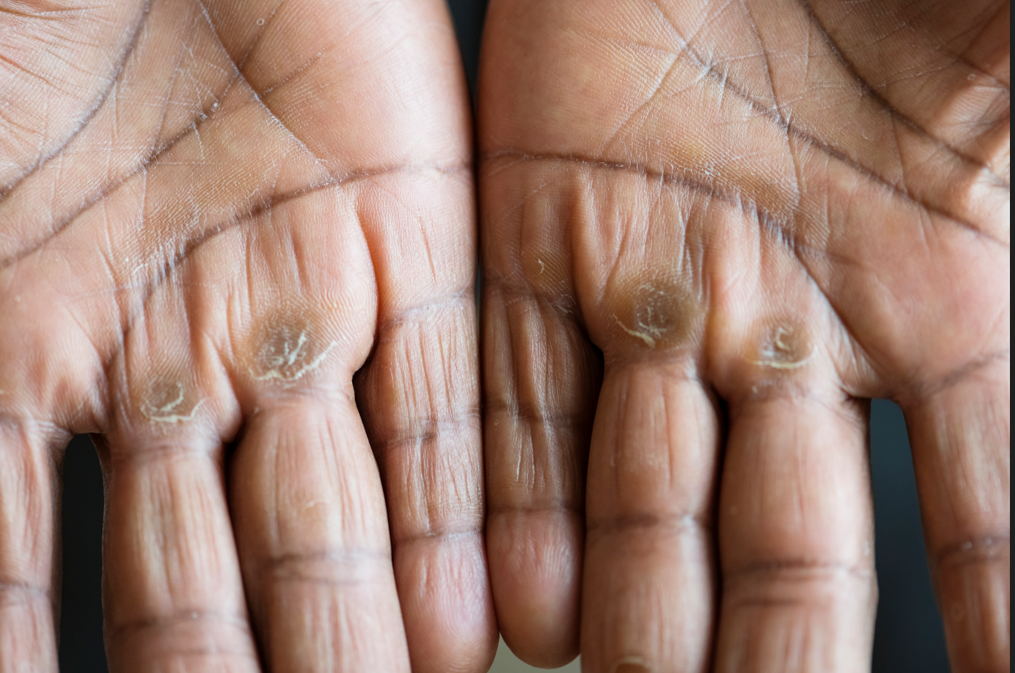
A callus is similar to a corn, and it is found on the skin. Calluses occur due to repeated pressure put on the area of skin. A person with a callus has extra layers of skin growing over the affected skin area until a hard, raised bump forms. This is part of the body’s mechanism to protect the skin, that is affected from breaking or being exposed to irritants.
A callus on the finger does not usually hurt, however, sometimes, the area underneath them may hurt when pressure is applied. Calluses can also form in other areas of the body, like the knees, palms, heels, and toes. These are areas that may be exposed to repeated pressure for example, walking barefoot, wearing tight fitting shoes, playing instruments like a guitar, or working with the hands. Calluses aren’t a medical problem and they may not need one to seek emergency care. However, for cosmetic purposes, they can be removed or a person can use some natural remedies to get rid of them.

Table of Contents
Calluses vs Corns
People may refer to calluses as corns, but these two aren’t the same. A callus is part of skin that is thickened and tough because of pressure, friction, or irritation, and mostly occurs on feet, hands, knees, and elbows. They are yellowish to pale in color. Calluses feel lumpy upon touching, however, because the skin is thick, it may feel less sensitive to touch.
Calluses are usually bigger and wider when compared to corns. They also have less defined edges and mostly appear in area of skin that frequently rubs against something for example, footwear, born, or the ground. Calluses mainly develop over the bony part just under fingers or toes, these are areas of skin, which tend to take weight or pressure when a person is walking or doing some tasks.
On the other side, a corn is a type of callus that comprise dead skin. You will find corns forming on smooth, hairless surfaces of skin particularly on the upper side of toes. Corns are small and circular in shape and they have clearly defined centers that feel hard or even soft. Corns occur in parts of firm, hard skin, where the individual’s skin has become thicker or in areas where calluses exist. They can also occur in bony parts of the individual’s foot.
With soft corns, they appear whitish in color often having a rubbery texture and are common in the areas in between the toes. Soft corns can also form on moist, sweaty skin. While both calluses and corns aren’t usually harmful, they could contribute to infections and ulcerations of skin. This commonly occurs in people who are diabetic or individuals having poor circulation in their feet.
Calluses – Signs and Symptoms
Calluses, just like corns can make an individual feel as though they are stepping or walking on stones, that’s if they are found on the foot. A person may have signs and symptoms like:
- Raised, hardened bumps
- Thick and rough skin
- Flaky and dry or waxy skin
- Pain and tenderness under the individual’s skin
Patients having fragile skin, poor circulation, or nerve problems in their hands and feet need to consult a doctor. Also, people with diabetes, peripheral arterial disease, and peripherical neuropathy should be careful and seek medical help if they have calluses. A podiatrist can help in the treatment of painful cases of calluses.
Causes of Calluses
There are many things that could contribute to formation of calluses. Usually, they occur because of friction, pressure, or even irritation on skin. You may develop calluses if:
- You frequently get in contact with things that put friction and pressure on skin
- You wear shoes that are so tight or high-healed
- Wear shoes that are too loose and which cause friction
- Wear shoes with badly placed seam that rubs against the tissue of skin
- Wear no socks
- Regularly walk barefoot
- Engage in repeated actions like walking or jogging
- You are older because the body tends to have less fatty tissue so there is little padding on skin
Removal of Calluses
To get rid of calluses, a podiatrist may cut them away using a scalpel. This helps to relieve pressure that is put on the tissue underlying the callus. It is not advised to cut calluses or corns by yourself because it can be very painful while also increasing the risk of having an infection.
Home Remedies for Calluses on Finger
You can soak the callus in warm water for about 10 minutes to soften it before scraping or filing the area using a pumice stone. You can use sideways or circular motions to file or scrape the dead skin.
A moisturizer applied on the fingers can also help soften the calluses to prep them for filing. These moisturizing products contain ingredients like urea, ammonium lactate, and salicylic acid that help to soften the dry skin and make it easy for a person to file or scrap it off.
Avoiding actions that are causing calluses may also help reduce them, for example, changing the way you walk, wearing shoes that fit properly, and having well placed seams on shoes. Also, wear socks and protective pads or even insoles to help reduce friction. You can wear silicon or foam wedges on the areas in between toes to reduce friction and pressure. There are custom-made padded inserts you can put in shoes, and they are known as orthotics. People who have an underlying foot deformity that contributes to formation of calluses or corns use them.
You may also use apple cider vinegar to soften the hardened skin. What you need to do is to mix four parts of water with one part of apple cider vinegar then soak the callus for up to 20 minutes. After the calluses soften, you can peel the hardened skin layers one by one. Make sure you don’t pull too hard because it could break the skin around causing an infection.
Using castor oil helps to lubricate the calluses. This can help when you’re preparing the skin for filing or rubbing. Take some warm water and mix with 5 tablespoons castor oil to lubricate the toughened skin. Castor oil also helps to soothe the area.
You can use Epsom salt to get rid of calluses. This salt is used as an exfoliator and contains fine grains that dissolve on skin to sooth it. You can mix 2 tablespoons of Epsom salt on bowl of warm water then soak the calluses to allow it soften for easier peeling.
It is also possible to remove calluses using lemon juice and baking soda. Lemon juice has acid component and when it combines with the chemical sodium hydrogen carbonate, it sparks a reaction to allow calluses to wear out.
People with calluses are advised to refrain from using razor or some sharp item to cut the skin. This is because when you cut the skin, it could be exposed to microbes like bacteria resulting in an infection. If you have calluses that are weeping pus, or bleeding and changing color, you need to see a doctor. A podiatrist can help to lance or cauterize an infected area of a callus.



Be the first to comment